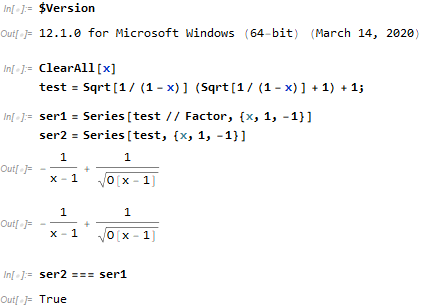I had to work with some series expansions lately, and at some point I realised that something was becoming inconsistent at some point. It seems that applying Factor broke my series expansions. Here's a minimal example extracted from my computations.
Consider the following expression
test = Sqrt[1/(1 - x)] (Sqrt[1/(1 - x)] + 1) + 1;
Now look at those series expansions of test around x=1:
ser1 = Series[test // Factor, {x, 1, -1}]
ser2 = Series[test, {x, 1, -1}]
Not only are ser1 and ser2 different, but what's worse is that
ser2 - ser1
gives 1/(x-1) + O(x-1)^0. At this point I would have expected O(x-1)^0, how come Factor can break a series expansion so much? Is this sort of behaviour a feature or a bug?
The problem seems to be in ser2, if one looks at List@@ser2 one realises that ser2 is saved as a0+O(x-1)^2 with a0 containing x, this seems to be the root of all evil.
Interestingly, if one alters test to
test = 1/Sqrt[(1 - x)] (1/Sqrt[(1 - x)] + 1) + 1;
which is really not much of a change, one obtains a different result. Given this instability, I don't know how I should trust the series expansions at all.
Here's a similar, but more subtle computation, which leads to two different results. Let's add 1/(1-x) to test
test = 1/(1 - x) + 1/Sqrt[1 - x] (1/Sqrt[1 - x] + 1) + 1;
ser1 = Series[test // Factor, {x, 1, -1}];
ser2 = Series[test, {x, 1, -1}];
and compute
Limit[(1 - x) ser1, x -> 1] (* = 2 *)
Limit[(1 - x) ser2, x -> 1] (* = 1 *)
In a realistic scenario test would be much more complicated, and I wouldn't compute both ser1 and ser2 and then compare, but just one of them. So there's a 50/50 chance that I'd obtain a wrong result without being aware of it.
Mathematica Version : 11.1 .0 .0
Platform : Mac OS X x86 (32-bit, 64-bit kernel)




bugstag for now. As mentioned in thebugstag statement, it is only used when the bug is validated by the community here. It seems like a bug, but let's let the expert community decide. $\endgroup$ser1andser2are to different orders. If I change the definition ofser1so that the resulting series is the same order as that inser2, I obtain the same result. So, I do not think this is a bug. $\endgroup$